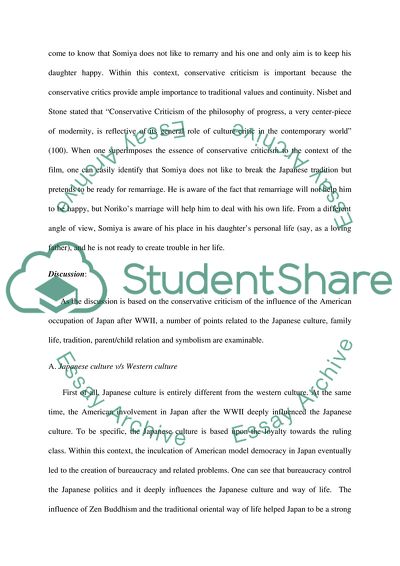Cite this document
(Yasujiro Ozu's Late Spring Essay Example | Topics and Well Written Essays - 2250 words, n.d.)
Yasujiro Ozu's Late Spring Essay Example | Topics and Well Written Essays - 2250 words. https://studentshare.org/visual-arts-film-studies/1768645-yasujiro-ozus-late-spring-1949-is-a-conservative-criticism-of-the-influence-of-the-american-occupation-of-japan-after-wwii-discuss
Yasujiro Ozu's Late Spring Essay Example | Topics and Well Written Essays - 2250 words. https://studentshare.org/visual-arts-film-studies/1768645-yasujiro-ozus-late-spring-1949-is-a-conservative-criticism-of-the-influence-of-the-american-occupation-of-japan-after-wwii-discuss
(Yasujiro Ozu'S Late Spring Essay Example | Topics and Well Written Essays - 2250 Words)
Yasujiro Ozu'S Late Spring Essay Example | Topics and Well Written Essays - 2250 Words. https://studentshare.org/visual-arts-film-studies/1768645-yasujiro-ozus-late-spring-1949-is-a-conservative-criticism-of-the-influence-of-the-american-occupation-of-japan-after-wwii-discuss.
Yasujiro Ozu'S Late Spring Essay Example | Topics and Well Written Essays - 2250 Words. https://studentshare.org/visual-arts-film-studies/1768645-yasujiro-ozus-late-spring-1949-is-a-conservative-criticism-of-the-influence-of-the-american-occupation-of-japan-after-wwii-discuss.
“Yasujiro Ozu'S Late Spring Essay Example | Topics and Well Written Essays - 2250 Words”. https://studentshare.org/visual-arts-film-studies/1768645-yasujiro-ozus-late-spring-1949-is-a-conservative-criticism-of-the-influence-of-the-american-occupation-of-japan-after-wwii-discuss.


